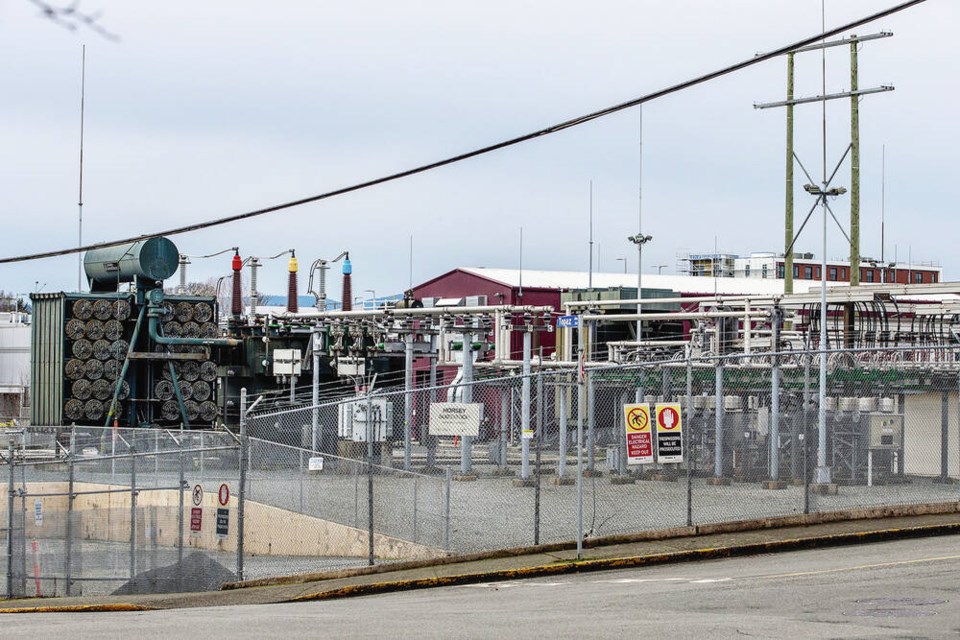Construction is expected to begin late next year on replacing two aging underground power transmission cables in Greater Victoria, a process that’s expected to cause traffic disruptions on major throughways in Victoria, Saanich and Esquimalt.
A replacement for the aging 7.1-kilometre-long oil-insulated power transmission cable connecting two substations in Victoria and Saanich is in the planning stages.
B.C. Hydro is hosting a one-hour virtual open house for the project on Friday, starting at noon.
Stephen Watson, a B.C. Hydro stakeholder-engagement adviser, said the aging power line has a “moderate” risk of failure and needs to be replaced to maintain electricity reliability in the capital region.
“Certainly, the biggest issue will be traffic and traffic management,” Watson said, adding that single-lane-alternating traffic will be expected along Interurban Road during construction.
The other underground cable that needs replacement is between Victoria and Esquimalt. Watson said that replacement is more urgent due to recently discovered cable corrosion. “We found that the outside sheath was deteriorating and had a higher risk of failure.”
Last August, that line suffered a leak, spilling about 255 litres of coolant oil in a park near the Selkirk Trestle, with some of that oil making its way into the Gorge Waterway.
Replacement of the power transmission cable linking Victoria and Esquimalt could begin as early as late 2025, while work on the Victoria-Saanich cable will start around 2026, pending regulatory approval and funding.
Work on the Victoria-Saanich transmission cable could take around two years.
A separate consultation for the Victoria-to-Esquimalt cable-replacement project will be scheduled for next month.
The two cables are among the oldest transmission lines in the region.
The underground 230 kV power cable that runs from the Horsey substation on Topaz Avenue in Victoria along Burnside Road East and Interurban Road to the Goward substation opposite Camosun College’s Interurban campus first went into service in 1976.
The cable that runs from the Horsey substation to the Esquimalt substation on Devonshire Road through Banfield Park and the Gorge Waterway was installed in 1980.
Both new cables will use a polyethylene plastic for insulation instead of mineral oil and will have more than double the capacity the current transmission cable can handle, Watson said.
He said the replacement for the Victoria-Saanich cable will occur in three stages.
Crews will have to dig ductwork to house the new power transmission line. Installation of the power cable itself will be a fairly quick process. “We’ll pull it [through the ductwork] with large reels.”
Lastly, the old cable will be dug up and its route remediated in 2028 once the new cable is operating.
Depending on the section, the new transmission cable might run alongside Interurban’s shoulder or within the road itself, Watson said.
Watson acknowledged the difficulty of working along the two-lane Interurban, which is a main connection to Camosun’s Interurban campus.
Traffic-management plans will be developed for both projects before they break ground.
While B.C. Hydro did not give a cost estimate for either cable, Watson said the replacement cable between the Horsey and Goward substations is expected to cost over $100 million. The cable-replacement work is expected to be done by a mix of B.C. Hydro workers and contractors.
Any capital project exceeding $100 million goes through the B.C. Utilities Commission, a provincial regulator. B.C. Hydro plans to submit an application for the Victoria-Saanich replacement project this fall.
Watson said the new cables can accommodate the region’s anticipated growth for the next 40 years.
During winter and periods of peak electricity demand, two-thirds of the electricity consumed on Vancouver Island comes through two undersea lines linking Vancouver Island to the mainland.
Greater Victoria electricity users receive their power through four substations in the region, some of which have received steady upgrades throughout the years.
In 2016, B.C. Hydro completed work on a $10-million 230 kV underground transmission cable between the Horsey substation and the George Tripp substation on Lochside Drive.
B.C. Hydro is planning for an additional substation to be built in Langford for 2030 to accommodate population growth in the West Shore, but has yet to select a location.
The power company is expected to spend $36 billion over the next decade to upgrade the province’s electrical infrastructure, at a rate of $3.6 billion a year.
With population growth, housing construction, and the switch from fossil fuels to cleaner electricity sources, electricity demand in the province is expected to increase by 15% or more between now and 2030.
Those wanting to attend the open house can register at bchydro.com/energy-in-bc/projects/victoria-saanich-cable.html.
>>> To comment on this article, write a letter to the editor: [email protected]



